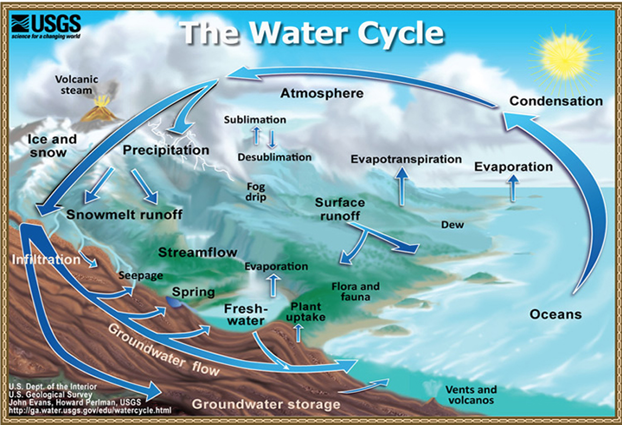Concerns about Long-Term Water Security
“Plans to protect air and water, wilderness and wildlife are in fact plans to protect man.” – Stewart Udall
Water is a precious natural resource required by all living things, including humans, to survive. Unlike some natural resources, water is considered to be renewable, circulating from the earth to the sky and back again via the water cycle. Although considered renewable, declining freshwater supplies and increasing pollution of freshwater are contributing to limited water availability for human use. Many regions of the world, including areas of the United States, already face water shortages. Globally, 748 million people currently do not have access to improved drinking water (water that has been sanitized to reduce risks of contamination), and that number is projected to increase 400 percent between 2000 and 20501. Access to clean water is a critical component to human health and survival.
Water is essential for environmental, social and cultural, and economic sustainability. Environmentally, water gives rise to and sustains life. Cultures’ success is largely determined by their relationships with water. From local to global scales, economies are dependent on water. Whether water is used for growing food, brewing tea, carrying ships, or providing habitat, water is key to life.
The small amount (less than 1 percent) of freshwater that is available for human use moves around earth and its atmosphere through a process called the water cycle (Figure 1). On this journey, water recharges rivers, streams, lakes, aquifers, and provides rainwater for plants, trees, and crops. It’s through this process that water can become contaminated and, more so, move contaminants around the earth and between water and air. Contamination of water reduces its quality and limits its use by humans and nature. Water insecurity can also be introduced by unchecked consumption. If more water is consumed than is recycled, supplies will decline and can become scarce. Many times, it is human interaction that threatens the condition (quality) or amount (quantity) of water.

This publication highlights the importance of water by explaining how water moves around the earth and the atmosphere and the concerns for long-term water security.
Subsequent articles will focus on specific issues surrounding water and what action can be taken to manage water for a sustainable future.
The Water (Hydrologic) Cycle
Water is always moving. Water on the earth’s surface is constantly transported from bodies of water (ponds, reservoirs, rivers) into the atmosphere in the form of water vapor. This process, called evaporation, is similar to boiling water on a stove, but at a much slower rate. Evaporation can take place from the surface of vegetation, which is called evapotranspiration. No matter the source of evaporation, water vapor travels for miles upward and around the atmosphere, and accumulates to form clouds. When conditions are right, water vapor further collects to form droplets. These droplets eventually fall to the ground as precipitation (rain, snow, sleet, or hail, depending on the season and weather conditions).
During a precipitation event, water may fall to the ground or be intercepted by plants or structures (roofs). Then, either it is re-evaporated or it falls to the earth’s surface. If water reaches the earth’s surface, it has three options: it can evaporate from the earth’s surface, collect on the surface or flow across the landscape to lower elevations (runoff), or infiltrate into the ground. The majority of precipitation, once it reaches the earth, is subject to a combination of these processes. Water that flows (eventually into a water body) or collects aboveground is called surface water.
Groundwater is water that infiltrates below the surface. It can be held in soil or travel through soil and sediment layers. Groundwater is held in-between sediment particles in large storage areas called aquifers. Water is stored in the earth’s crust in shallow or deep aquifers. Groundwater is very dynamic, which means it can change forms—solid (ice), liquid (water), and gas (water vapor)—and it can move vertically between layers of the earth and horizontally under the earth. Once water moves underground, it can still interact with surface waters. For example, some streams are “fed,” or receive some inflowing groundwater, where water from the ground can flow back to the surface by springs. This is typical in streams, lakes, rivers, and even oceans. Additionally, vertical movement may take place through geysers and pumping for human use. Water can also move horizontally beneath the earth’s surface, as slow-moving underground rivers. This horizontal movement may also contribute to streams, rivers, and oceans depending on the depth of the groundwater (i.e., water table).
As water flows through the water cycle, there are many points where physical (sediments, turbidity), chemical (fertilizers, pesticides, toxins, drugs), biological (bacteria, viruses, parasites), or radiological (plutonium, uranium) contamination can occur. This degradation of water quality usually begins in surface water, but it can infiltrate into groundwater. When contamination levels in water resources become too high, it can harm people, plants, and animals depending on the water source, location, and use. It is important to recognize common sources and types of contamination so that it can be prevented.
Concerns: Sources of Water Contamination
There are two general types of contamination sources: point sources and nonpoint sources. Point source (PS) pollution is when a particular water pollutant can be traced to a single confined source, such as a pipe or channel. Nonpoint source (NPS) pollution is defined as any source of pollution that is not a point source. NPS is much harder to trace to a specific source, as this type of pollution results from runoff, precipitation, atmospheric deposition, drainage, seepage, or hydrologic modification.
Untreated or mismanaged wastewater (effluents) from factories and sewage treatment plants are two common types of PS pollution. In the United States, wastewater is regulated by the EPA under the Federal Water Pollution Control Act Amendments of 1972 (the Clean Water Act). Regulations help keep drinking water safe for humans and animals. They also keep recreational activities such as swimming and fishing safe. These regulations have positive economic effects for industries that depend on clean waters. The EPA’s National Pollutant Discharge Elimination System (NPDES) regulates the quality of water leaving possible contaminating facilities and discharging to waters of the United States. Because of regulation, many point sources of pollution have been eliminated.
Surface water runoff transports NPS pollutants such as sediment, fertilizers, oils, heavy metals, or other chemicals. A recognizable form of NPS pollution takes place after heavy rainstorms in parking lots. As pools gather in the lots, a rainbow-colored sheen, caused by oil-based chemicals that drip from vehicles onto the pavement, can be seen on the water surface. Runoff from agricultural fields can contain fertilizers and pesticides, which also commonly contributes to NPS pollution of waterways. It is recommended that best management practices be implemented in areas where NPS pollution is a concern. This will help prevent degradation of water quality downstream.
Figures 2 and 3 show examples of PS pollution and NPS pollution. The two types are distinguished by the source from which the pollutant originates.

Source: U.S. Environmental Protection Agency

Source: USDA Soil Conservation Service
Concerns: Water Use and Availability
There are many ways humans depend on water. Some uses are easy to identify, like drinking, washing, watering plants, and swimming. Some uses don’t immediately come to mind but are also very important—cooking, medical care, and firefighting. Other water uses include crop irrigation, hydroelectric generation, cooling systems, and transportation. And there are many other examples of how water helps people perform daily tasks.
Not all uses of water have the same demands on water resources. In the state of Mississippi, agriculture was the dominant sector of daily water usage in 2010. Agriculture accounted for 54 percent (2.029 billion gallons of water used per day) of the state’s total water use (among domestic and public, industrial, thermoelectric, and mining). The combined use of the agriculture and thermoelectric sectors totaled 79 percent of the average total daily use (3.117 billion gallons of water used per day)6.
It’s important to understand where our water comes from so we can better manage water resources. Mississippians get domestic water from groundwater and reservoirs; these sources are also used for commercial, industrial, thermoelectric, and agricultural purposes6. Mississippi currently has abundant water resources to support the needs of industries, agriculture, and citizens. However, the largest water-using sector—agriculture—depends heavily on groundwater resources. Concerns over water scarcity are on the rise because the rate at which groundwater is being removed is much faster than the rate it is being recharged. As agriculture is extremely important to the state economy, water conservation efforts are under way to reduce the water use deficit.
Conclusion
Water resource protection continues to be a top priority in many regions of the world, and, as clean freshwater supplies become scarcer, solutions will be needed to meet human and environmental demands. Modern and novel technology will be necessary in regions that have abundant water resources but don’t currently have access to them due to infrastructure or sanitation issues. Other solutions might include social and nontechnological innovations, in which people simply slow their rate of water use or move to areas that have more abundant water resources. Governments, from federal to local levels, will also be faced with deciding how water is rationed between agricultural, industrial, domestic, and environmental needs. Most importantly, citizens should remain informed about the issues surrounding water resource use and allocation.
Everyday citizens can take action to protect the water resources where they live. Collectively, citizens will be the ones to influence water policy, water quality, and the water budget. You can get involved by staying informed, protecting water resources, making others aware, participating in water resource conservation groups, monitoring the water resources in your area, and contacting government representatives and policymakers about these issues.
References
WWAP (United Nations World Water Assessment Programme). 2015. The United Nations World Water Development Report 2015: Water for a Sustainable World. Paris, UNESCO.
Water Science Glossary of Terms. 2016. Retrieved June 20, 2016, from http://water.usgs.gov/edu/dictionary.html.
Point Source Pollution. 2008. Retrieved June 20, 2016, from https://oceanservice.noaa.gov/education/tutorial_pollution/03pointsource.html.
Boyd, C. A., and Pierce, T. 2010. The Hypoxic Zone in the Gulf of Mexico. Mississippi State University Extension Service: Publication 2583.
Nonpoint Source Pollution. 2008. Retrieved June 20, 2016, from https://oceanservice.noaa.gov/education/tutorial_pollution/04nonpointsource.html.
USGS Water Use Data for Mississippi. (n.d.). Retrieved June 21, 2016, from http://waterdata.usgs.gov/ms/nwis/water_use/.
The information given here is for educational purposes only. References to commercial products, trade names, or suppliers are made with the understanding that no endorsement is implied and that no discrimination against other products or suppliers is intended.
Publication 2997 (POD-01-23)
By Caleb Aldridge, former Research Associate, Wildlife, Fisheries, and Aquaculture; Beth Baker, PhD, Associate Extension Professor, Wildlife, Fisheries, and Aquaculture; and Austin Omer, former Extension Associate, Wildlife, Fisheries, and Aquaculture.
The Mississippi State University Extension Service is working to ensure all web content is accessible to all users. If you need assistance accessing any of our content, please email the webteam or call 662-325-2262.



